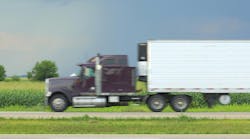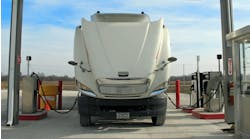This is Part Three of a three-part series.
With diesel fuel prices increasing across the country, every fleet knows the value of investing in fuel efficiency for their trucks. In Part One of this series, we discussed most recently-released trucks and how ther specs set them up to conserve fuel as much as possible. Then, in Part Two, we delved into how powertrain developments and aerodynamic tools help to stretch a gallon of gas even further.
Finally, it's time to examine how fleets can fine tune smaller truck components to increase their miles per gallon, specifically in spec'ing tires, wheels, and engine oils for maximum efficiency.
Tires and wheels
NACFE Executive Director Mike Roeth said some fleets have gone to single wide-base tires after shifting their focus to fuel efficiency. “That said, the low rolling resistance of some duals have really come a long way. Fleets need to look into that, too, to determine what their best option is,” Roeth explained.
Most tire OEs offer rolling resistance calculators to help fleets determine what may be best for them.
Wheel covers and fairings are good add-ons to help improve aerodynamics. They reduce turbulence around the wheel ends and cavities, which reduces drag.
“Wheel covers can generate a 0.93% fuel efficiency gain on a tandem-axle tractor alone,” said David Black, VP of fleet sales at FlowBelow, an aerodynamic tool provider. “When you add wheel covers to the trailer position, you can pick up another 0.81%. That’s a 1.74% total improvement.”
Beyond wheel covers, Black said more fleets are also looking to add fairings to the drive wheel position. FlowBelow markets wheel covers and fairings together in what it calls its Tractor AeroKit. Black said the full AeroKit can help improve fuel efficiency by another 1.44%, bringing the total fuel efficiency opportunity to over 3%. Black said fleets can spec FlowBelow’s AeroKit from the factory at every Class 8 OE.
Truck hub units can also reduce wheel-end friction to improve efficiency. For example, SKF says the Scotseal X-Treme adds lower frictional torque to the system compared to other available seals which contributes to improved fuel consumption.
According to Cengis Shevket, president of North America aftermarket sales for SKF Group, the Scotseal X-Treme can save up to 10 gallons of fuel per seal annually. Considering a tractor has six seals and a trailer has four more, that’s a saving of 100 gallons per tractor-trailer.
“If you multiply that across a fleet of 100, 200, 300 vehicles—it adds up pretty quickly,” Shevket said.
Engine oils
When the new Model Year 2027 trucks start hitting the market, there will also be a new class of engine oils. We’re talking 20-weight viscosities that will take fuel economy to another level. In the meantime, a fleet could have an opportunity to start migrating toward these looming low-viscosity oils to see some fuel savings now.
Read more: How TruckWings improve fuel efficiency
“Getting fleets to feel comfortable with lower-viscosity lubricants has been one of the challenges with current lubricant technology,” said Bhaskar Prabhakar, product performance advisor at ExxonMobil. He’s talking about the CK-4 and FA-4 class of oils that rolled out nearly eight years ago. The limited adoption of 10W-30 in both CK-4 and FA-4 has been disappointing. But he’s not entirely surprised.
“Adoption requires a significant mindset shift away from the idea that 15W-40 is always better in terms of wear protection,” Prabhakar said. “The reality is that a 10W-30 can provide the same wear protection, while also providing the fuel economy benefits. An oil marketer would never put a product out there that was incapable of protecting the engine.”
A fleet must first ensure that the engine is capable of handling a lower-viscosity FA-4. If it is, a fuel efficiency gain of 1-2% over a sustained period of time is realistic. “We even have data showing 3% in some instances,” Prabhakar pointed out.
Even when moving toward a lower-viscosity engine oil, maximizing fuel economy depends on several additional factors, from aerodynamics and powertrains to fuel quality and driver behavior.
“Maximum fuel economy is this magic number fleets are always chasing,” Prabhakar said. “There are many ways to get to that number. All of those little details that provide some benefit will add up.”
One more little detail to keep in mind is good preventive maintenance.
“You have to change the oil at the recommended interval,” Prabhakar reminded. “It’s also important to make sure all of those moving components in the engine are taken care of. Next to good fuel, good preventive maintenance is the best thing a fleet can do for fuel economy. Even a fleet that doesn’t want to invest in the latest and greatest engine technology can benefit from these things which they can control.”
And with fleets expecting increased expenses in the coming years, knowing there are options to cut one of the highest ones should at least help them sleep a little better at night.






